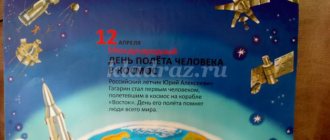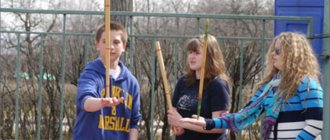Military sports games in kindergarten on May 9 and February 23
Game REPORT
Children are divided into two teams. Each team receives an important package that must be delivered to headquarters. If a WWII veteran is present at the celebration, the package can be delivered to him.
The test for speed, agility and dexterity begins at the signal of the leader. Children need to overcome obstacles on the way to headquarters: run along a bridge, crawl under a wire, jump over a ditch, go through a swamp. The last participant gives the package to the veteran.
Another version of this game in kindergarten: a squad of four fighters moves towards the headquarters, moving the boards.
Game WOUNDED FIGHTERS
Girls dressed in nurse costumes take part in the game. To do this, you can use children's costumes according to professions. They play in twos. Opposite the girls sit boys - “wounded soldiers”.
At the signal, the girls must squat down to the boys, bandage their arms and legs, and deliver the wounded soldier to the medical unit. The boy walks leaning on the girl.
Game DELIVERY SHELLS
Children are divided into two teams. Each participant takes one stuffed bag from the basket.
Children receive a task - to deliver bags to baskets located at the other end of the room. To do this, the “fighters” will have to run around pins, jump over circles, and crawl under arcs.
Game HIT THE TARGET
This is a continuation of the game DELIVER THE SHELLS. Children take turns running the same way to the basket, take out one projectile from there and try to get it into the hoop. They run back and pass the baton.
Game CROSSING
Children are divided into two teams. The first participant stands with his feet in one hoop, the second holds it in front of him. At a signal, he throws the second hoop in front of him, jumps into it, and repeats the same thing with the freed hoop.
In this way you need to get to the counter, go around it and return to the team.
Game CONSTRUCTION
Each team is given a sheet of A2 size with a drawn diagram of military equipment, consisting of geometric figures (the contours of each figure are marked), and an envelope with colored parts for the diagram.
The number of parts in all schemes is the same.
The following models of military equipment were selected for the competition: tank, battleship, airplane.
Teams need to post a color image on the diagram.
DIDACTIC GAMES FOR DEFENDER OF THE FATHERLAND DAY (CARD INDEX)
CARD FILE OF DIDACTICAL GAMES FOR SENIOR PRESCHOOL CHILDREN ON THE TOPIC “OUR DEFENDERS”
Didactic game “What an artilleryman needs”
Target:
To consolidate children's knowledge about the military profession of artilleryman; develop visual attention; instill pride in our Army.
Progress of the game:
Children choose photographs or pictures depicting military equipment, paraphernalia (tank, military aircraft, flag, pistol, horse, flask, binoculars, cannon, etc.). The selected pictures must correspond to the military profession of artilleryman. The child gives reasons for his choice (why the artilleryman needs this item).
Didactic game “Who will I serve in the Army?”
Target:
Strengthen children's knowledge about military professions; develop imagination and cultivate pride in our Fatherland.
Progress of the game:
Children are presented with pictures or photographs depicting weapons, equipment, objects and attributes used by the military. Based on the choice the child made, the military profession should be determined. Name what troops the child wants to serve in when he grows up.
Didactic game “Who protects our borders”
Target:
To consolidate children's knowledge about military air, land, and sea transport; develop cognitive activity; educate patriots of your country.
Progress of the game:
On the map of Russia, the teacher shows the borders of our country. Draws children's attention to the fact that borders pass not only on land, but also on water. He clarifies that it is also impossible to cross the border by air. Children answer the teacher’s questions regarding what type of military transport they use to protect the borders. Justify your answer. For example, if the enemy attacks from the sea, the border will be protected by warships and boats. If the threat is on land, then tanks, guns, and military equipment are on guard.
Didactic game "('leave the card»
Tasks;
Strengthen children's knowledge about the map of Russia; develop visual memory, cultivate pride in our Motherland.
Progress of the game:
To carry out the game, preliminary work is required to familiarize preschoolers with maps of Russia, region, city and city. I A color physical map of Russia in A4 format is cut into 6-8 parts (depending on the age of the children). It is proposed to compile a whole map of the country from parts. Complication: collect a card against time.
Didactic game “Guess the military profession”
Target:
consolidate children's knowledge about military professions (tanker, military pilot, artilleryman, border guard, etc.); develop observation and memory; cultivate love for the Motherland.
Progress of the game:
The presenter (child) describes a representative of one of the military professions. Children must determine by their characteristic features who the presenter has wished for. Whoever guessed first becomes the leader.
Didactic game “Let’s collect a picture”
Target:
Strengthen children's knowledge about military transport; develop fine motor skills of the hands; instill pride in our Army.
Progress of the game:
Children are offered cut-out pictures of a tank, a military aircraft, a military helicopter, a military boat, a submarine, and a military vehicle. Offer to assemble a whole image from parts. Game options: children assemble a whole image from parts in pairs, make a whole from parts against time, at speed.
Didactic game “How the great-grandfathers defended the world”
»
Purpose: To consolidate the concepts: water, land, air military transport; develop visual and auditory attention; cultivate a sense of pride in our great-grandfathers who defended the world for us
Progress of the game: The child chooses a picture depicting a military profession. Selects military transport in accordance with the chosen profession. Then, in accordance with the chosen military transport, it “stops” at the border of our country. For example, profession - military sailor, transport - military boat, border - sea area.
Didactic game “What an artilleryman needs”
Tasks:
To consolidate children's knowledge about the military profession of artilleryman;
develop visual attention; instill pride in our Army. Progress of the game
Children choose photographs or pictures depicting military equipment, paraphernalia (tank, military aircraft, flag, pistol, horse, flask, binoculars, cannon, etc.). The selected pictures must correspond to the military profession of artilleryman. The child gives reasons for his choice (why the artilleryman needs this item).
Didactic game “Who will I serve in the Army?”
Tasks:
Strengthen children's knowledge about military professions;
develop imagination; instill pride in our Fatherland. Progress of the game
Children are presented with pictures or photographs depicting weapons, equipment, objects and attributes used by the military. Based on the choice the child made, the military profession should be determined. Name what troops the child wants to serve in when he grows up.
Didactic game “Who protects our borders”
Tasks:
To consolidate children's knowledge about military air, land, and sea transport;
develop cognitive activity; educate patriots of your country. Progress of the game
On the map of Russia, the teacher shows the borders of our country. Draws children's attention to the fact that borders pass not only on land, but also on water. He clarifies that it is also impossible to cross the border by air. Children answer the teacher’s questions regarding what type of military transport they use to protect the borders. Justify your answer. For example, if the enemy attacks from the sea, the border will be protected by warships and boats. If the threat is on land, then tanks, guns, and military equipment are on guard.
Didactic game “Make a map”
Tasks:
Strengthen children's knowledge about the map of Russia;
develop visual memory; instill pride in our Motherland. Progress of the game
To carry out the game, preliminary work is required to familiarize preschoolers with maps of Russia, region, city, etc. A color physical map of Russia in A4 format is cut into 6-8 parts (depending on the age of the children). It is proposed to compile a whole map of the country from parts. Complication: collect a card against time.
Didactic game “Guess the military profession”
Tasks:
consolidate children's knowledge about military professions (tanker, military pilot, artilleryman, border guard, etc.);
develop observation and memory; cultivate love for the Motherland. Progress of the game
The presenter (child) describes a representative of one of the military professions. Children must determine by their characteristic features who the presenter has wished for. Whoever guessed first becomes the leader.
Didactic game “Let’s collect a picture”
Tasks:
Strengthen children's knowledge about military transport;
develop fine motor skills of the hands; instill pride in our Army. Progress of the game
Children are offered cut-out pictures of a tank, military aircraft, military helicopter, military boat, submarine, military vehicle. Offer to assemble a whole image from parts. Game options: children assemble a whole image from parts in pairs, make a whole from parts against time, at speed.
Didactic game “How our great-grandfathers defended the world”
Tasks:
Reinforce the concepts: water, land, air military transport;
develop visual and auditory attention; to cultivate a sense of pride in our great-grandfathers, who defended the world for us. Progress of the game:
The child chooses a picture depicting a military profession. Selects military transport in accordance with the chosen profession. Then, in accordance with the chosen military transport, it “stops” at the border of our country. For example, profession - military sailor, transport - military boat, border - sea area.
“Who knows, he will guess!”
Target:
- Strengthen children's knowledge about the sights of their hometown;
- Develop memory, speech;
- Cultivate observation and curiosity.
Progress of the game: The child, with his eyes closed, takes one postcard on the table with views of his hometown, then gives a brief description, without naming the place itself. The rest of the children ask leading questions until the place of their hometown is guessed. The child who answers correctly becomes the leader. The game repeats itself. At the beginning of the game, the teacher can give his story - a sample.
"Find the flag"
Target:
- To consolidate children's ideas about the national flag;
- Develop attention and memory;
- Foster a sense of patriotism.
The presenter lays out postcards on the table with images of flags of different countries (about ten) and gives the children the task of finding the Russian flag. Then the teacher invites the children to close their eyes and at this time swaps the pictures.
“Find out the coat of arms of our country”
Target:
- To consolidate children's knowledge about the state emblem;
- Learn to recognize the coat of arms of other countries;
- Develop attention and memory;
- Cultivate a desire to learn something new.
Progress of the game: The teacher invites the children to look at the national flag of Russia and name what colors it consists of. Next, children are offered cut-out pictures (like puzzles). Children collect the Russian flag.
"There are guests in our city"
Target:
- Consolidate knowledge about your hometown in a playful way;
- Develop speech, memory;
- Cultivate love for your hometown.
Progress of the game: The teacher warns the children that now out-of-town guests who know nothing about our city will come to us. Children must give short descriptive stories about their hometown. The “guest”, with the help of leading questions, encourages children to talk about the climate, the flora and fauna, the symbolic meaning of the coat of arms, and names the name of the head of the city.
Didactic game “Walk around the city”
Tasks:
consolidate students’ ideas about the streets of the nearest microdistrict and the buildings located on them; expand understanding of buildings and their purpose; establish rules for safe behavior on the street; expand spatial representations (left, right, in front, behind, between, next to, opposite, in the middle, etc.); develop coherent monologue speech; cultivate love and respect for your hometown.
Material:
the playing field is green, on which road maps with traffic lights and a green zone are indicated in gray; photographs of city institutions and institutions (10-15 pieces) closest to the kindergarten; permanent objects (landmarks) on the playing field (for example: airport, monuments, circus); cards with riddle poems – 10-15 pcs.; cubes with photographs of institutions pasted on each side - 3 pcs.; figurine of a man – 1 pc.; photographs of the city, cut into mosaic shapes.
The game can be played by one child or a subgroup of children – 3-5 people.
Preliminary work:
targeted walks to nearby streets, examining the buildings located on them; conversations about what you can see when you open the door of the establishment, what it is intended for; viewing a photo album of the city; comparison of large photographs with small game cards; familiarization with the playing field - a diagram of the nearest streets.
Game options:
Option 1 – “Find a street.”
The child is asked to place a figurine of a man on the street that the teacher names. (All buildings are on the playing field).
Option 2 – “Riddles on the streets of the city.”
The game uses a playing field and poetry cards. The teacher hands out photographs to the playing children, reads riddle poems, and the children guess what kind of establishment they are talking about. The child who has a photo of the mysterious building places it on the playing field. You should strive to use spatial terms in speech. First, you can guess the most familiar objects closest to the kindergarten, then more distant ones.
Option 3 – “Get home.”
The child is asked to determine the location of his house on the playing field - place a figurine of a man there. The task is to describe the route from home to kindergarten and back, observing traffic rules.
Option 4 – “Show me the way.”
The game uses a playing field with all the objects attached to it and cubes with photographs. The child throws the dice. The task is to explain the way from the kindergarten to the establishment shown on the cube, observing the traffic rules.
Option 5 – “What’s mixed up?”
The teacher deliberately places photographs of buildings on the playing field incorrectly. Children are encouraged to correct mistakes by commenting on their actions.
Option 6 – “Complete the picture.”
Children are given the task, together with their parents, to walk along the streets closest to the kindergarten and find establishments there that are not found in the game.
Option 7 – “Assemble the mosaic.”
The cut fragments of photographs are mixed, the children have to correctly assemble the image and explain where it is and what it is intended for.
Didactic game “Let’s go to our native land”
Age:
pupils of the senior group.
Tasks:
to clarify students’ ideas about the flora and fauna of their native land; expand ideas about the uniqueness of the animal and plant world depending on the natural area; develop coherent monologue speech of preschoolers; practice classifying natural objects; consolidate ideas about the symbolism of Bryansk, about large cities of Russia; cultivate love for one's native land.
Material:
images of two locomotives: one with the coat of arms of Bryansk, the second with the emblem of the southern countries; images of six carriages; 3 sets of pictures: animals (10 pcs.), berries (6 pcs.), trees (6 pcs.) of Russia; 3 sets of pictures: animals (10 pcs.), fruits (6 pcs.), trees (5 pcs.) of southern countries; map of Russia.
Game actions:
1. Select and place in the pocket of the carriage only those cards that correspond to the completion of the task.
2. Talk about the features of the animals’ habitat, about the place where trees, fruits, and berries grow.
3. It is reasoned to prove why the object cannot travel to Russia or to the south (connect with the characteristics of the animal’s appearance, nutrition, fruit growing conditions, etc.).
Game rules:
Preliminary agreement between two players: which version of the game to choose, who will take the objects where. Think, do not interfere with each other, and help if necessary.
Game options:
Option 1 – “Who goes where”.
On the table in front of the child are 2 locomotives with carriages, pictures depicting one type of object (animals or trees, berries, fruits). Assignment: select objects based on natural areas and, depending on this, plant them either with the coat of arms of Bryansk, or with the emblem of the southern countries.
Option 2 – “Classifier”.
Offer the children all the pictures at once, a locomotive with three carriages.
Assignment: in accordance with the symbolism of the locomotive (remember, tell what it means), put the animals in the first carriage; in the second - berries or fruits, in the third - trees, i.e. classify objects.
Option 3 – “Correct errors.”
The teacher places pictures in the carriage pockets in advance, deliberately making mistakes.
Assignment: correct mistakes, giving a reasoned explanation of your answer (for example: why a hippopotamus cannot live in Russia. Connect with the peculiarities of appearance, lifestyle, nutrition).
Option 4 – “An extraordinary journey”.
All pictures with animals and a map of Russia are included. All animals travel from Bryansk to the north (south, west, east) of the country. Trace on the map which major cities you meet along the way
Task: plant the animal in the city in which the first sound in the name coincides with the first sound in the name of the animal.
Game NAME THE PROVERB
Children stand in a circle. Passing the flag to each other, they remember proverbs about soldiers and the Motherland.
Proverb options:
- Hero for the Motherland by the mountain.
- A brave fighter in battle is well done.
- The bullet fears the brave, but the bayonet does not kill the brave.
- Motherland. Know how to stand up for her!
- Feel free to go into battle, the Motherland is behind you.
- Your own land and in your fist.
Game GUESS AND NAME
This assignment will require pre-kindergarten work. The teacher must find photographs of cities that took part in the Second World War: Leningrad, Moscow, Stalingrad, Smolensk. The selection of photographs consists of modern views and views of cities during the war.
For example, Stalingrad:
Moscow:
The teacher asks the children questions:
- Which city do you know?
- What differences do you see between the photographs?
Paper tank
A military paper craft will be a good gift for February 23rd. How to make a tank out of paper? Assembling the product with your own hands is not very difficult.
Note!
- DIY crafts for May 9 step by step: 150 photos of the best crafts for Victory Day
DIY crafts for February 23rd step by step: master class with photos and descriptions of how to make crafts for Defender of the Fatherland Day
Crafts on the theme of spring: master class on creating original spring crafts with your own hands (120 photo ideas)
To make this craft you will need:
- Colored paper.
- Matchboxes.
- Scissors.
- Small diameter tube or toothpick.
To make a quality craft for a gift, you need to follow the pattern.
- Cover the matchboxes with green or black colored paper. This will be the body of the tank.
- Cut the caterpillars out of paper according to the size of the body. Glue black circles inside to act as wheels. Next, you need to glue the tracks onto the body evenly on both sides.
- Attach a toothpick or tube to a matchbox, which represents the tank turret. You can stick a red star or some kind of inscription on the tower for decoration.



